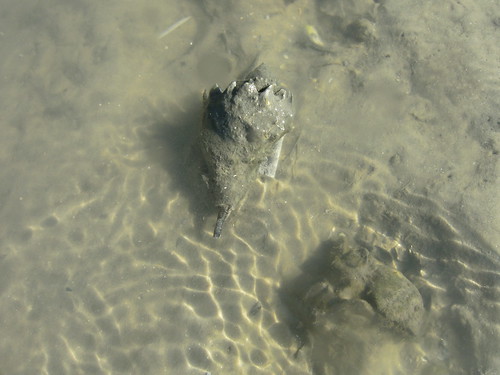
Scanning the photo, you can see crown conchs crawling about this Saint Augustine reef. Crown conchs are a normal sight on Florida reefs, but not to the extent seen here. David has tasked Hanna Garland with looking into this very localized phenomenon and its relationship with increasing reef failures.
Dr. David Kimbro FSU Coastal & Marine Lab
 Last week I detailed a recent trip to St. Augustine, ending the post with a mention of a side project being embarked upon by my lab there. Throughout the past year, we’ve noticed that our St. Augustine study site was loaded with tons of crown conchs. Although crown conchs are ubiquitous in Florida, they are abnormally abundant on our St. Augustine reefs and our St. Augustine reefs are mostly dead. All our other sites have relatively healthy looking oyster reefs and few crown conchs.
Last week I detailed a recent trip to St. Augustine, ending the post with a mention of a side project being embarked upon by my lab there. Throughout the past year, we’ve noticed that our St. Augustine study site was loaded with tons of crown conchs. Although crown conchs are ubiquitous in Florida, they are abnormally abundant on our St. Augustine reefs and our St. Augustine reefs are mostly dead. All our other sites have relatively healthy looking oyster reefs and few crown conchs.
But a few miles north of our monitoring reefs, we find absolutely no crown conchs and the health of the oysters is great. Because crown conchs, as has been shown by the research of our very own Doc Herrnkind, love eating oysters, it’s easy to conclude that crown conchs have mowed down all the oysters on our monitoring reefs. But why are they restricted only to our monitoring reefs? Is there a predator of conchs present north of reefs but that is absent on our monitoring reefs? Perhaps the environment has changed in a way that killed all of the oysters and the crown conchs are just cleaning up the mess.

Proboscis out (protruding from the bottom of the snail), a crown conch heads towards a clump of oysters. The conch will use its proboscis to pry open the oyster shell and suck out the meat.
Luckily, Hanna has agreed to enter my lab as a graduate student to tackle this research project. So, she spent a number of days collecting coarse-scale data on the spatial extent of this conch-oyster pattern, consulting with locals about when this pattern developed, and talking with an oceanographer about how to learn whether and how the physical environment has lead to this pattern. In a forthcoming post, I’ll let Hanna fill you in on the details of this new project, which we will be implementing quickly. This is really important to the local community because our monitoring reefs and the conch infested area used to be the most productive area in St. Augustine for harvesting oysters and rearing clams. But now, aquaculture leases here have been abandoned and a very large population of crown conchs appears to have taken up residence.
Stay tuned for Hanna’s post later this week, she’ll go into a little more detail on what we’re doing.

4 comments
[…] of the bar, facing the open Gulf. Hanna Garland, newly returned from her graduate study on the crown conch problem south of Saint Augustine, seemed to have found something interesting. Whenever there’s […]
I am a citizen scientist and I am working with a conch population in rose bay that does not seem to harm the oyster beds at all. I theorize that natural flushes of fresh water enter the bay changing salinity in the estuary, and from this many conches parish. I believe this works as a natural way to keep the population in check. with these conches the only thing that i am not sure of, is where these oyster bars are located in st. augustine. if these particular beds do not have changes in salinity than perhaps that is why the numbers grow out of control. any one who can help me with that please feel free to email me at quinnzacharias@yahoo.com
hi Quinn,
Thanks for sharing your idea, which coincidentally happens to be one of the many ideas we are testing. In addition to changes in salinity, we looked at whether their distribution is limited by predators of the conchs or other environmental stressors such as prolonged exposure during low tide. The work is still on-going, so I don’t have a definitive answer.
best of luck with your research into this matter.
cheers,
david
[…] […]
Comments are closed.